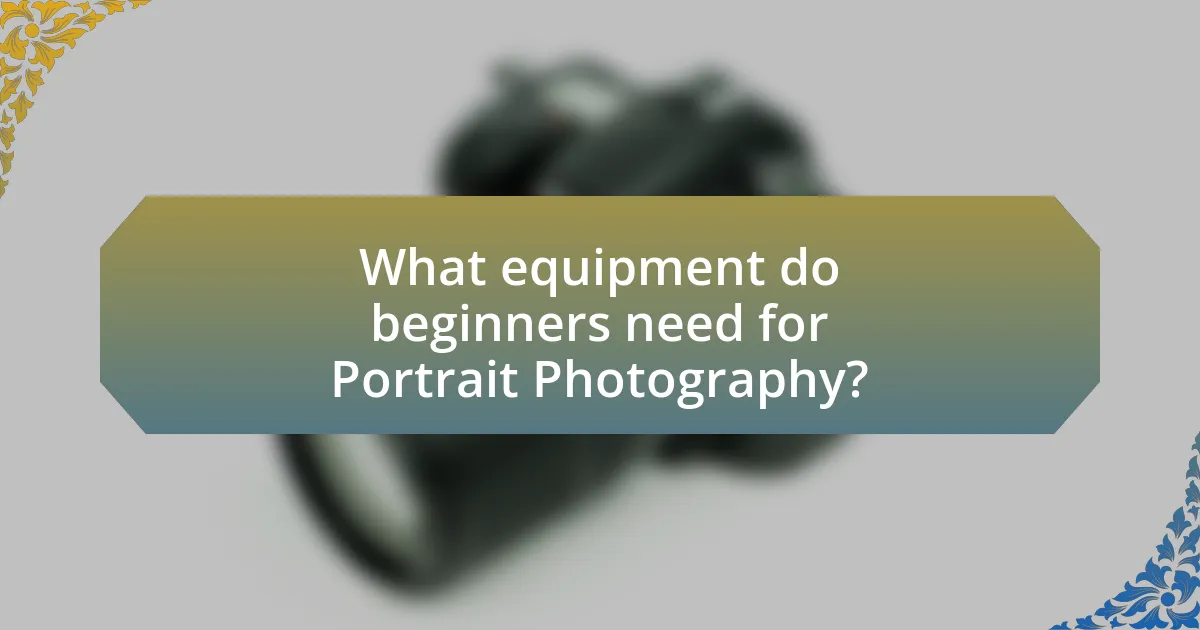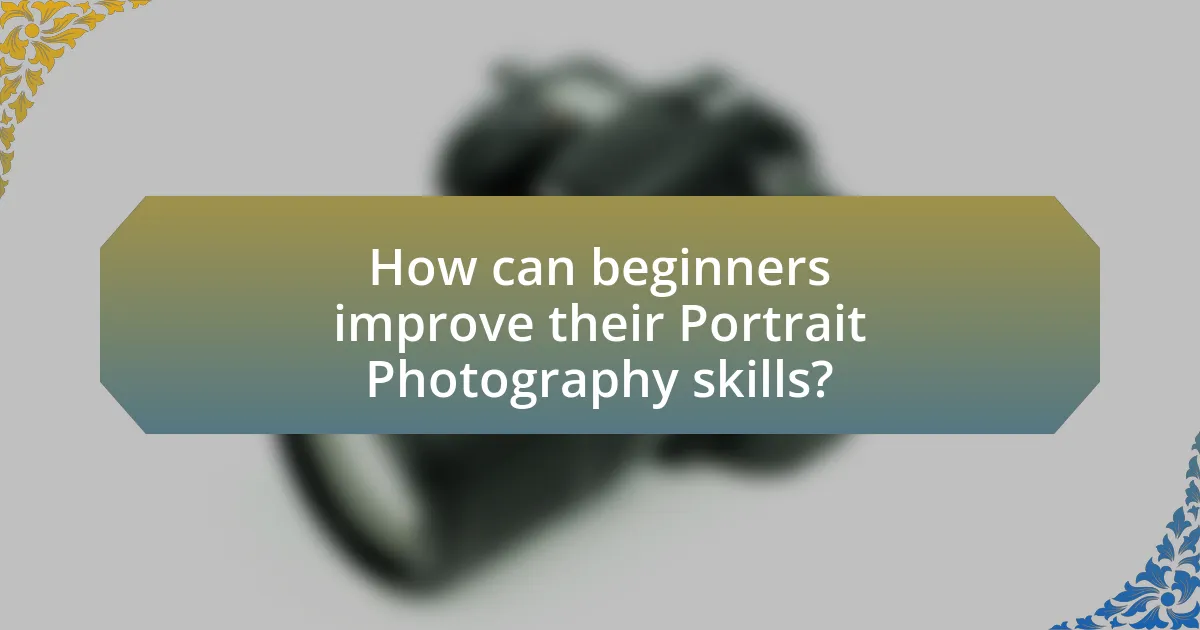Portrait photography is a specialized genre that captures the personality and mood of individuals or groups, emphasizing facial expressions and emotions through techniques like controlled lighting and composition. This article provides a comprehensive guide for beginners, covering essential aspects such as the differences between portrait photography and other styles, key characteristics, types of portraits, and the importance of understanding the subject’s personality. Additionally, it outlines necessary equipment, camera settings, and accessories that enhance portrait quality, while offering practical tips for improving skills, posing subjects, and utilizing lighting effectively. Common mistakes to avoid and strategies for achieving compelling portraits are also discussed, making this a valuable resource for aspiring portrait photographers.

What is Portrait Photography?
Portrait photography is a genre of photography that focuses on capturing the personality and mood of an individual or group. This type of photography often emphasizes the subject’s face, expressions, and emotions, typically using techniques such as controlled lighting and composition to enhance the visual impact. Historically, portrait photography has evolved from traditional painted portraits to modern digital photography, with significant milestones including the introduction of the daguerreotype in the 19th century, which made portraiture more accessible to the public.
How does Portrait Photography differ from other photography styles?
Portrait photography focuses specifically on capturing the likeness, personality, and mood of an individual or group, distinguishing it from other photography styles that may emphasize landscapes, events, or objects. Unlike landscape photography, which prioritizes the environment and scenery, portrait photography centers on the subject’s expression and character, often utilizing techniques such as controlled lighting and composition to highlight facial features. Additionally, while event photography captures moments in time, portrait photography is more about creating a narrative or connection with the subject, often involving direct interaction between the photographer and the person being photographed. This emphasis on personal connection and expression is what fundamentally sets portrait photography apart from other styles.
What are the key characteristics of Portrait Photography?
The key characteristics of portrait photography include a focus on the subject’s face, the use of lighting to enhance features, and the composition that conveys personality or emotion. Portrait photography aims to capture the essence of the subject, often utilizing shallow depth of field to isolate the subject from the background. Additionally, effective use of angles and framing can significantly impact the portrayal of the subject. These characteristics are essential for creating compelling and engaging portraits that resonate with viewers.
Why is understanding the subject’s personality important in Portrait Photography?
Understanding the subject’s personality is crucial in portrait photography because it enables the photographer to capture authentic expressions and emotions that reflect the subject’s true self. By recognizing personality traits, such as introversion or extroversion, the photographer can tailor the shooting environment and poses to elicit genuine reactions, resulting in more compelling and relatable images. Research indicates that portraits that resonate emotionally with viewers often stem from a deep understanding of the subject’s character, leading to a stronger connection between the subject and the audience.
What are the different types of Portrait Photography?
The different types of portrait photography include traditional portraiture, environmental portraiture, candid portraiture, self-portraiture, and glamour portraiture. Traditional portraiture focuses on posed subjects, often in a studio setting, emphasizing facial expressions and attire. Environmental portraiture captures subjects in their natural surroundings, providing context about their lives or professions. Candid portraiture involves capturing spontaneous moments, showcasing genuine emotions and interactions. Self-portraiture is created by the photographer themselves, often exploring personal identity or artistic expression. Glamour portraiture emphasizes beauty and fashion, often involving stylized poses and professional makeup. Each type serves distinct purposes and appeals to various audiences within the realm of photography.
How do environmental portraits differ from studio portraits?
Environmental portraits differ from studio portraits primarily in their setting and context. Environmental portraits are taken in the subject’s natural surroundings, which often reflect their personality, profession, or lifestyle, while studio portraits are captured in a controlled environment with artificial lighting and backdrops. This distinction highlights that environmental portraits aim to tell a story about the subject through their environment, whereas studio portraits focus on the subject alone, often emphasizing facial expressions and poses without external context.
What is the significance of candid portraits in storytelling?
Candid portraits are significant in storytelling because they capture authentic emotions and moments, providing a deeper connection to the subject. This authenticity allows viewers to engage with the narrative on a personal level, as the unposed nature of candid photography reveals genuine expressions and interactions. Research indicates that images reflecting real-life moments can evoke stronger emotional responses, enhancing the storytelling experience. For instance, a study published in the Journal of Visual Communication found that candid images are more likely to elicit empathy and relatability from audiences compared to staged photographs.

What equipment do beginners need for Portrait Photography?
Beginners in portrait photography need a digital camera, a prime lens, and a tripod. A digital camera allows for high-quality image capture, while a prime lens, typically with a focal length of 50mm or 85mm, provides a shallow depth of field, ideal for isolating subjects. A tripod stabilizes the camera, ensuring sharp images, especially in low-light conditions. These essential tools enable beginners to effectively capture portraits with clarity and artistic intent.
What camera settings are essential for capturing portraits?
To capture portraits effectively, essential camera settings include a wide aperture (f/1.8 to f/4) for shallow depth of field, a shutter speed of at least 1/125 seconds to avoid motion blur, and an ISO setting that balances exposure without introducing noise, typically between 100 and 400 in good lighting. A wide aperture creates a blurred background, emphasizing the subject, while a fast shutter speed ensures sharpness. The ISO setting should be adjusted based on lighting conditions to maintain image quality. These settings are widely recommended by photography experts and are fundamental for achieving professional-looking portraits.
How do aperture, shutter speed, and ISO affect portrait quality?
Aperture, shutter speed, and ISO significantly affect portrait quality by influencing exposure, depth of field, and motion blur. Aperture controls the amount of light entering the camera and affects depth of field; a wider aperture (lower f-stop number) creates a shallow depth of field, isolating the subject from the background, which enhances portrait quality. Shutter speed determines how long the camera’s sensor is exposed to light; faster shutter speeds freeze motion, preventing blur, while slower speeds can introduce motion blur if the subject moves. ISO measures the sensor’s sensitivity to light; higher ISO settings allow for better performance in low light but can introduce noise, degrading image quality. Balancing these three elements is crucial for achieving well-exposed, sharp, and aesthetically pleasing portraits.
What lenses are best suited for Portrait Photography?
The best lenses for portrait photography are typically prime lenses with a focal length between 85mm and 135mm. These lenses provide a flattering perspective and allow for a shallow depth of field, which helps to isolate the subject from the background. For example, an 85mm f/1.8 lens is widely recommended for its ability to create beautiful bokeh and sharp images, making it a favorite among portrait photographers. Additionally, a 50mm f/1.4 lens is also popular for its versatility and ability to produce high-quality portraits, especially in tighter spaces.
What accessories can enhance Portrait Photography?
Lighting equipment, such as softboxes and reflectors, can significantly enhance portrait photography by providing controlled and flattering light. Softboxes diffuse harsh light, creating a soft, even illumination that reduces shadows on the subject’s face. Reflectors bounce light back onto the subject, filling in shadows and adding dimension. Additionally, using a tripod stabilizes the camera, allowing for sharper images, especially in low-light conditions. A good quality lens, particularly a prime lens with a wide aperture, can also improve image quality by providing better sharpness and depth of field. These accessories are widely recognized in photography for their ability to improve the overall quality of portrait images.
How do reflectors and diffusers improve lighting in portraits?
Reflectors and diffusers enhance lighting in portraits by controlling and modifying light to create a more flattering and balanced illumination. Reflectors bounce light onto the subject, filling in shadows and reducing harsh contrasts, which results in a softer and more even light distribution. For instance, using a white reflector can increase the light on a subject’s face without altering the color temperature, while a silver reflector can add a more pronounced highlight. Diffusers, on the other hand, soften direct light by scattering it, which minimizes harsh shadows and reduces glare. This technique is particularly effective when shooting in bright sunlight, as it creates a more pleasing and natural look. Studies in photography emphasize that proper use of reflectors and diffusers can significantly improve the overall quality of portrait lighting, making subjects appear more vibrant and three-dimensional.
What role do tripods and remote shutters play in capturing portraits?
Tripods and remote shutters are essential tools in capturing portraits as they enhance stability and control during the shooting process. Tripods provide a stable platform that minimizes camera shake, allowing for sharper images, especially in low-light conditions or when using slower shutter speeds. Remote shutters eliminate the risk of camera movement caused by pressing the shutter button, enabling precise timing for capturing expressions and poses. Studies in photography emphasize that using these tools can significantly improve image quality and composition, making them invaluable for beginners aiming to achieve professional results in portrait photography.

How can beginners improve their Portrait Photography skills?
Beginners can improve their portrait photography skills by practicing composition techniques, understanding lighting, and mastering camera settings. Focusing on composition involves using the rule of thirds, leading lines, and framing to create visually appealing images. Understanding lighting is crucial; natural light during golden hour often yields the best results, while artificial lighting can be manipulated with softboxes or reflectors to enhance portraits. Mastering camera settings, such as aperture for depth of field and shutter speed for motion capture, allows beginners to control the outcome of their shots effectively. According to a study by the National Geographic Society, effective use of these techniques significantly enhances the quality of portrait photography, making it essential for beginners to practice and refine these skills.
What techniques can help in posing subjects effectively?
To pose subjects effectively, photographers can utilize techniques such as directing body angles, adjusting facial expressions, and incorporating natural movements. Directing body angles involves positioning the subject at a slight angle to the camera, which creates depth and interest in the composition. Adjusting facial expressions can be achieved by engaging the subject in conversation or prompting them to think of a specific emotion, resulting in more genuine expressions. Incorporating natural movements, such as having the subject shift their weight or interact with their environment, can lead to more dynamic and relaxed poses. These techniques are supported by studies in visual perception, which indicate that varied angles and expressions enhance viewer engagement and emotional connection in portrait photography.
How can body language and facial expressions enhance portraits?
Body language and facial expressions significantly enhance portraits by conveying emotions and personality traits that static images alone cannot express. Effective body language, such as posture and gestures, can create a sense of movement and engagement, while facial expressions provide insight into the subject’s feelings, making the portrait more relatable and impactful. Research indicates that portraits with expressive faces are perceived as more engaging and can evoke stronger emotional responses from viewers, as demonstrated in studies on emotional recognition in photography. This interplay between body language and facial expressions ultimately enriches the storytelling aspect of portrait photography, allowing for a deeper connection between the subject and the audience.
What are some tips for directing subjects during a shoot?
To effectively direct subjects during a shoot, communicate clearly and confidently. Clear communication helps subjects understand what is expected of them, reducing anxiety and improving their performance. Use specific instructions, such as “turn your head slightly to the left” or “smile naturally,” to guide their movements. Additionally, establish a comfortable atmosphere by engaging in light conversation, which can help subjects relax and appear more natural in front of the camera. Research indicates that relaxed subjects produce more authentic expressions, enhancing the overall quality of the portrait.
How important is lighting in Portrait Photography?
Lighting is crucial in portrait photography as it directly influences the mood, clarity, and overall quality of the image. Proper lighting can enhance facial features, create depth, and establish a specific atmosphere, while poor lighting can lead to unflattering shadows and loss of detail. Studies show that natural light, particularly during the golden hour, produces the most flattering results, as it softens skin tones and reduces harsh contrasts. Additionally, controlled artificial lighting allows photographers to manipulate shadows and highlights, further emphasizing the subject’s characteristics. Thus, effective lighting techniques are essential for achieving professional-looking portraits.
What are the differences between natural and artificial lighting?
Natural lighting refers to sunlight that illuminates a scene, while artificial lighting is produced by man-made sources such as lamps and flash units. Natural lighting varies throughout the day, influencing color temperature and intensity, which can create different moods in photography. In contrast, artificial lighting provides consistent control over brightness and direction, allowing photographers to manipulate the environment to achieve desired effects. Additionally, natural light is often softer and more diffused, especially during golden hour, while artificial light can be harsh if not modified. These differences significantly impact the aesthetics and technical aspects of portrait photography.
How can beginners utilize golden hour for better portraits?
Beginners can utilize golden hour for better portraits by scheduling their photo sessions during the hour after sunrise or before sunset when the sunlight is soft and warm. This lighting creates flattering skin tones and reduces harsh shadows, enhancing the overall quality of the portrait. Studies in photography indicate that golden hour light can improve image aesthetics significantly, making subjects appear more vibrant and natural.
What are common mistakes to avoid in Portrait Photography?
Common mistakes to avoid in portrait photography include poor lighting, unflattering angles, and neglecting the background. Poor lighting can lead to harsh shadows or overexposed highlights, which detract from the subject’s features. Unflattering angles can distort facial proportions, making the subject appear less appealing; for instance, shooting from below can create an unflattering perspective. Neglecting the background can result in distractions that take attention away from the subject, such as clutter or unwanted elements. By addressing these issues, photographers can significantly enhance the quality of their portraits.
How can improper focus ruin a portrait?
Improper focus can ruin a portrait by causing the subject’s features to appear blurry, which detracts from the overall quality and impact of the image. When the focus is not correctly set on the subject’s eyes, which are typically the focal point in portrait photography, it can lead to a loss of connection with the viewer and diminish the emotional resonance of the photograph. Studies in photography emphasize that sharp focus on the eyes is crucial for engaging portraits, as it draws the viewer’s attention and conveys the subject’s personality.
What are the pitfalls of poor composition in portraits?
Poor composition in portraits can lead to unflattering images that fail to convey the subject’s personality or emotion. When elements such as framing, balance, and focal points are neglected, the resulting portrait may appear cluttered or disjointed, distracting from the subject. For instance, placing the subject too centrally without considering the rule of thirds can create a static and less engaging image. Additionally, poor use of background can result in distractions that detract from the subject, making it difficult for viewers to connect with the portrait. These pitfalls can ultimately diminish the impact of the photograph, making it less memorable or effective in conveying the intended message.
What practical tips can beginners follow to enhance their Portrait Photography?
To enhance their portrait photography, beginners should focus on mastering lighting, composition, and communication with subjects. Proper lighting is crucial; natural light during golden hour provides soft, flattering illumination. Composition techniques, such as the rule of thirds, help create visually appealing images by guiding the viewer’s eye. Additionally, effective communication with subjects fosters comfort, resulting in more genuine expressions. These practices are supported by photography experts who emphasize the importance of these elements in creating compelling portraits.















